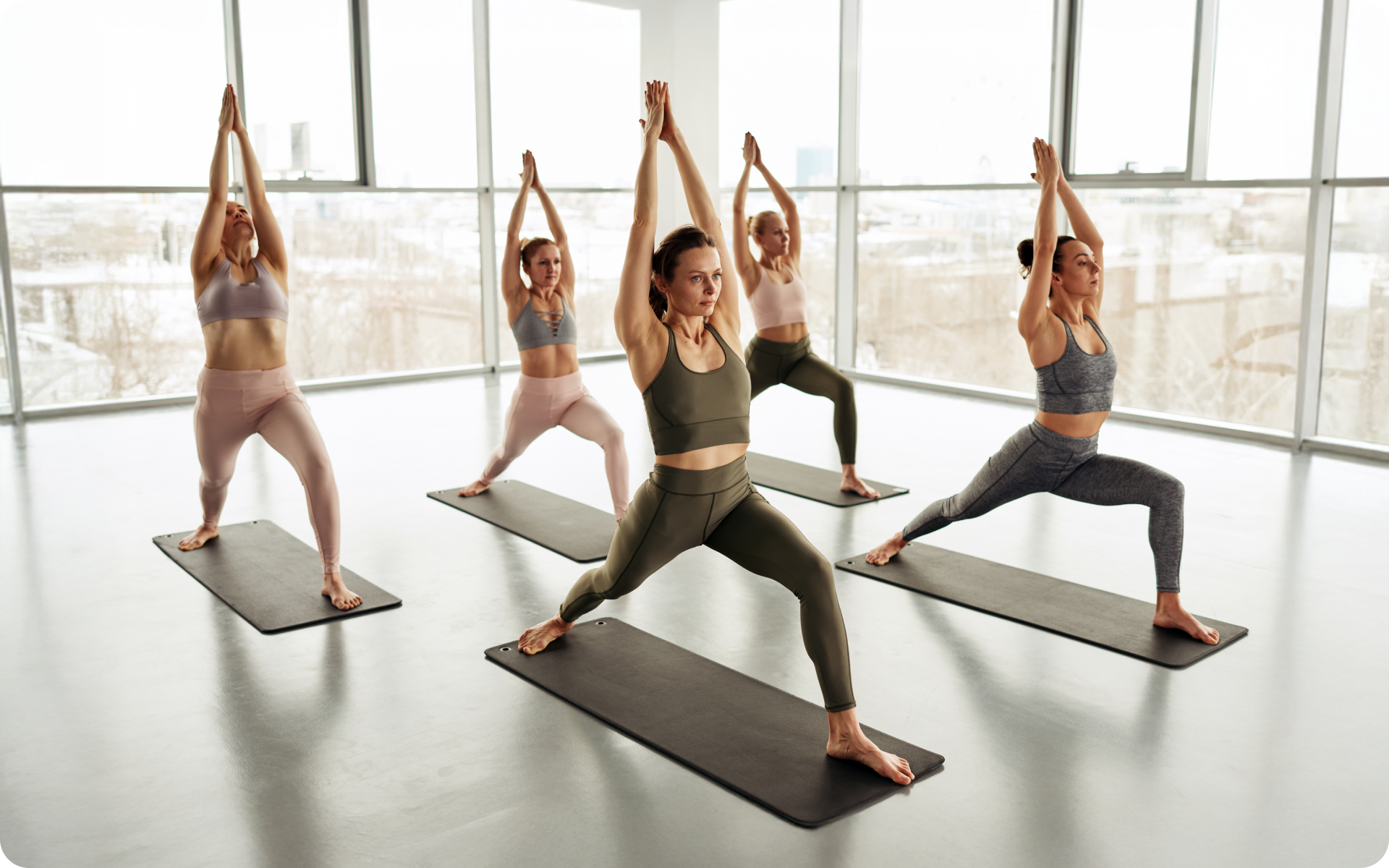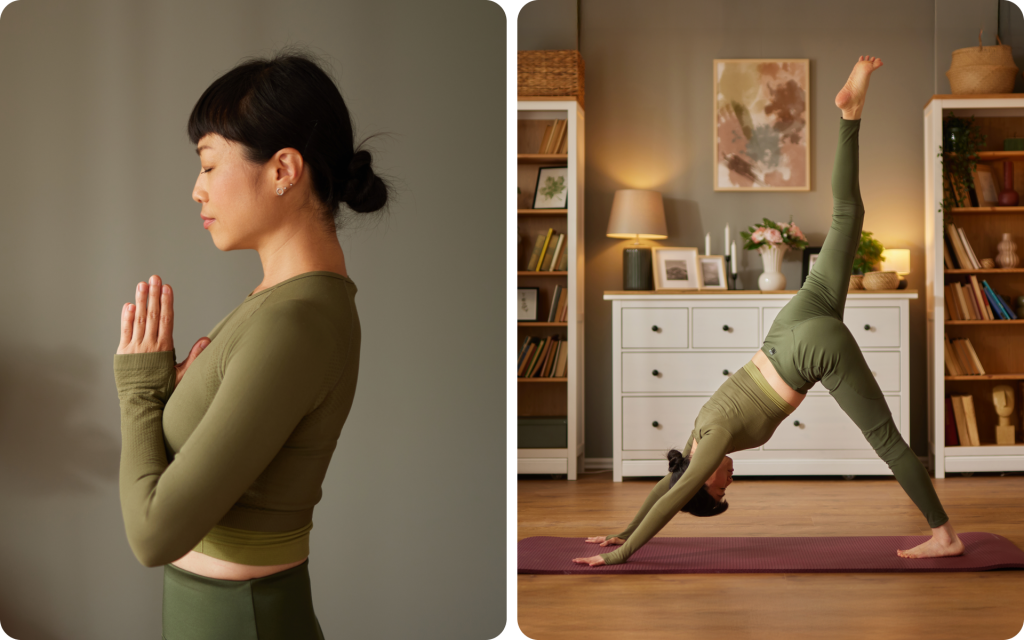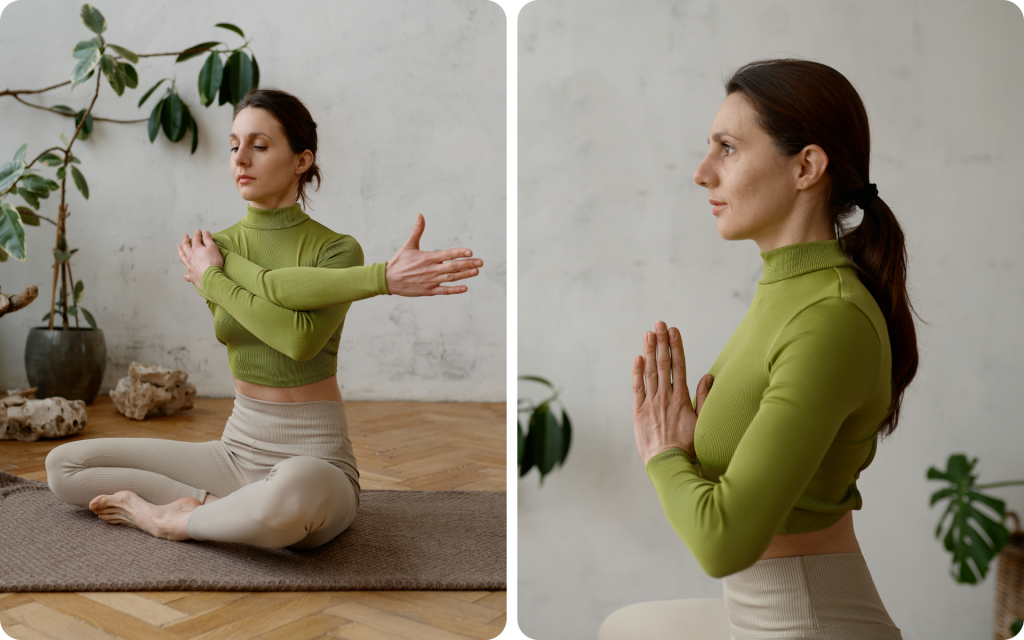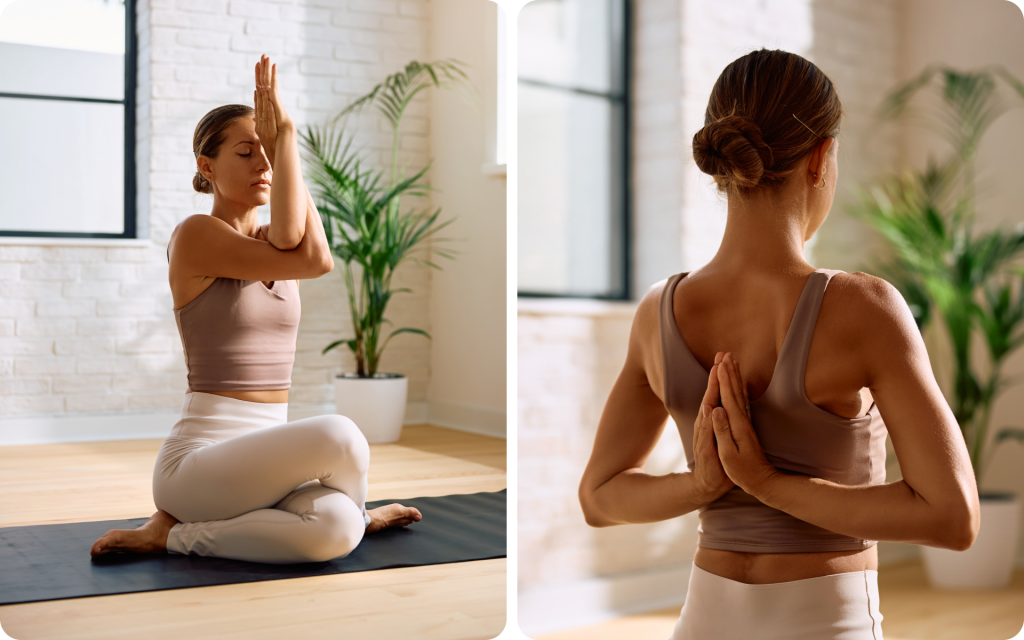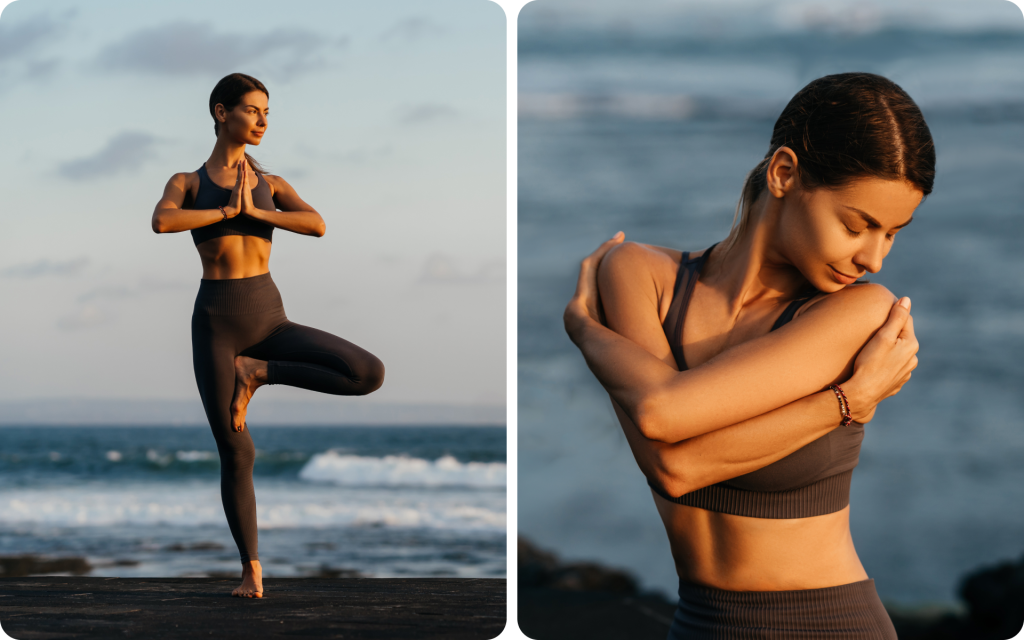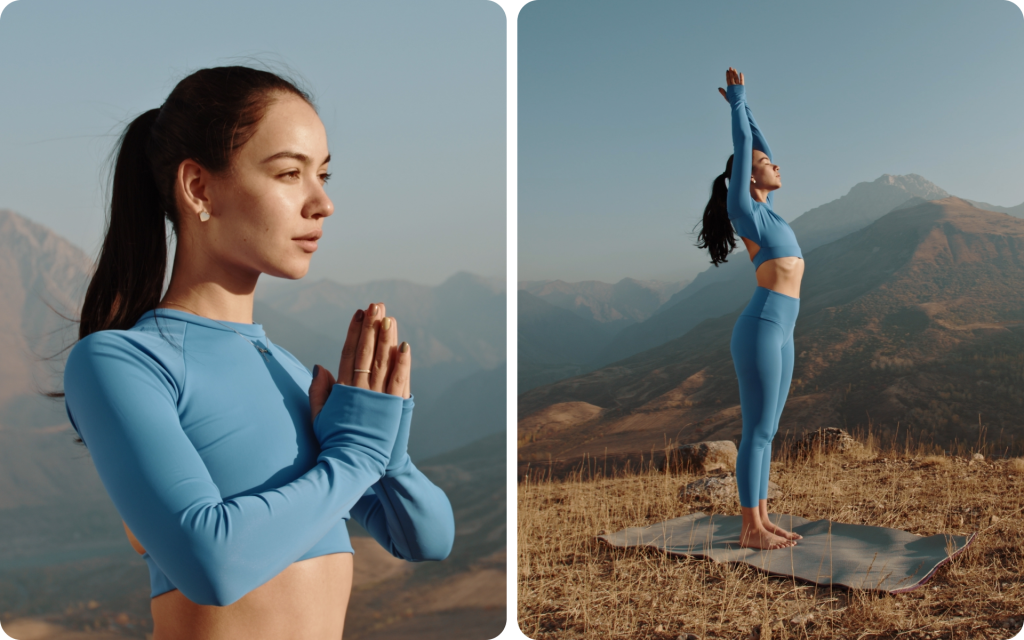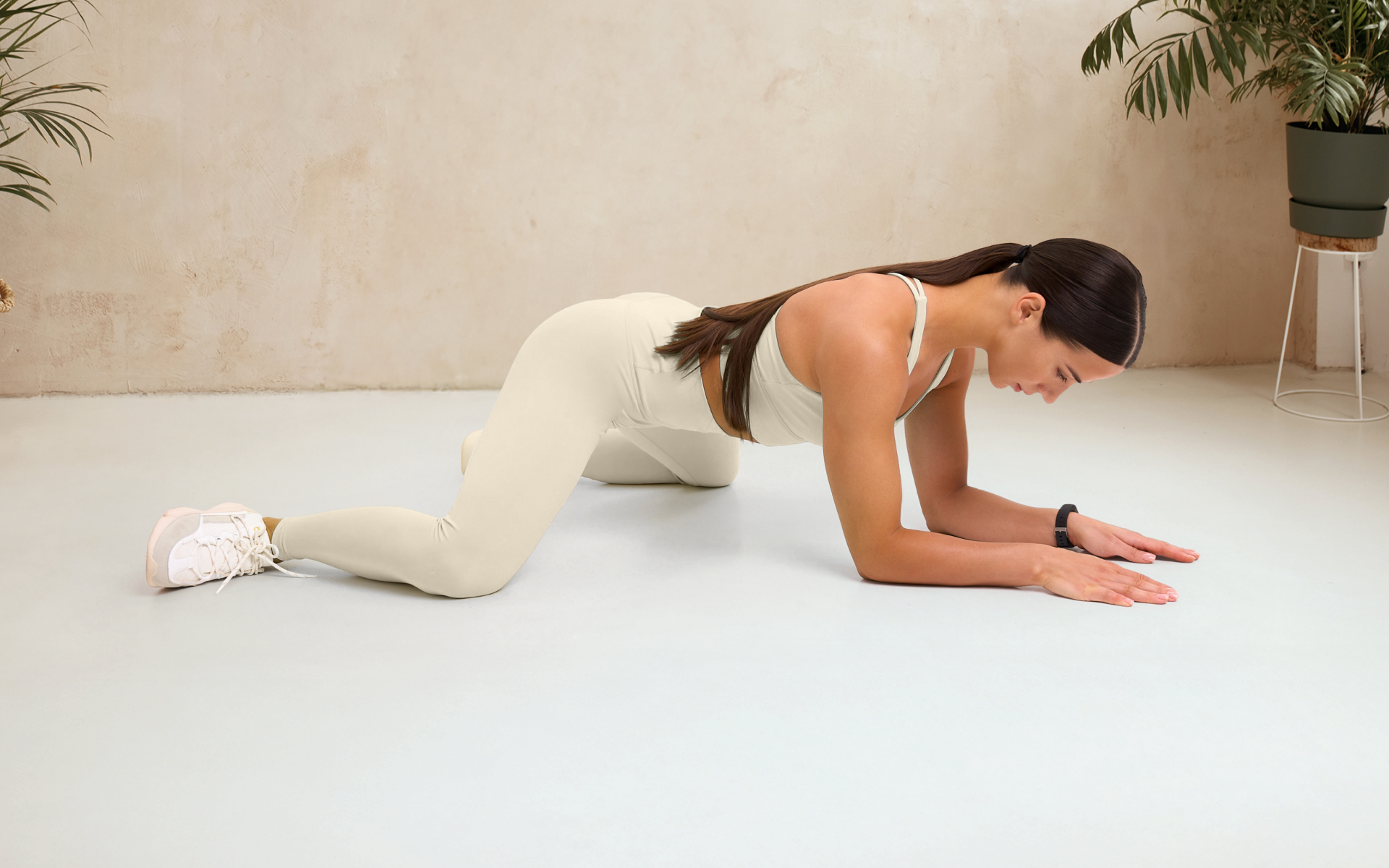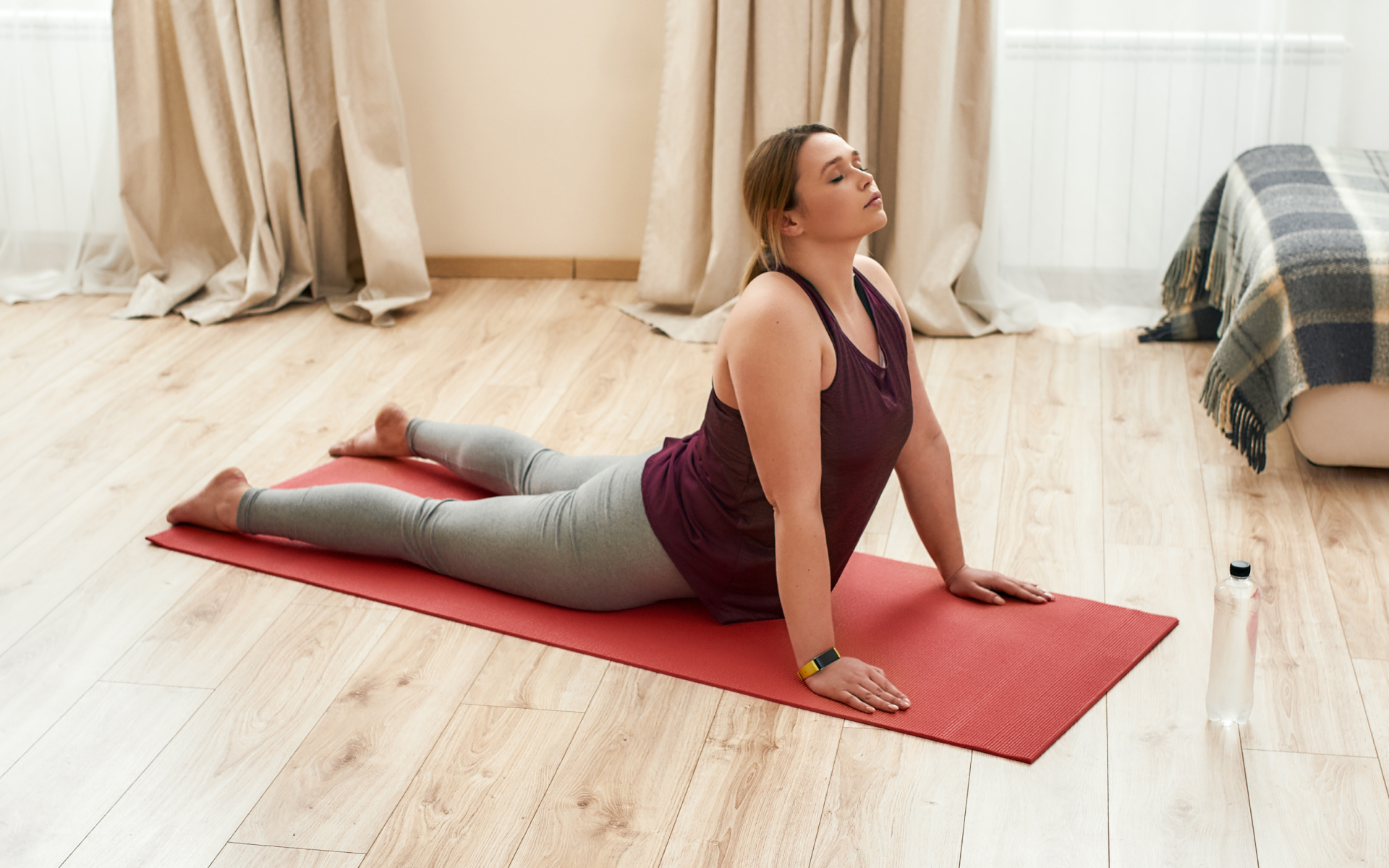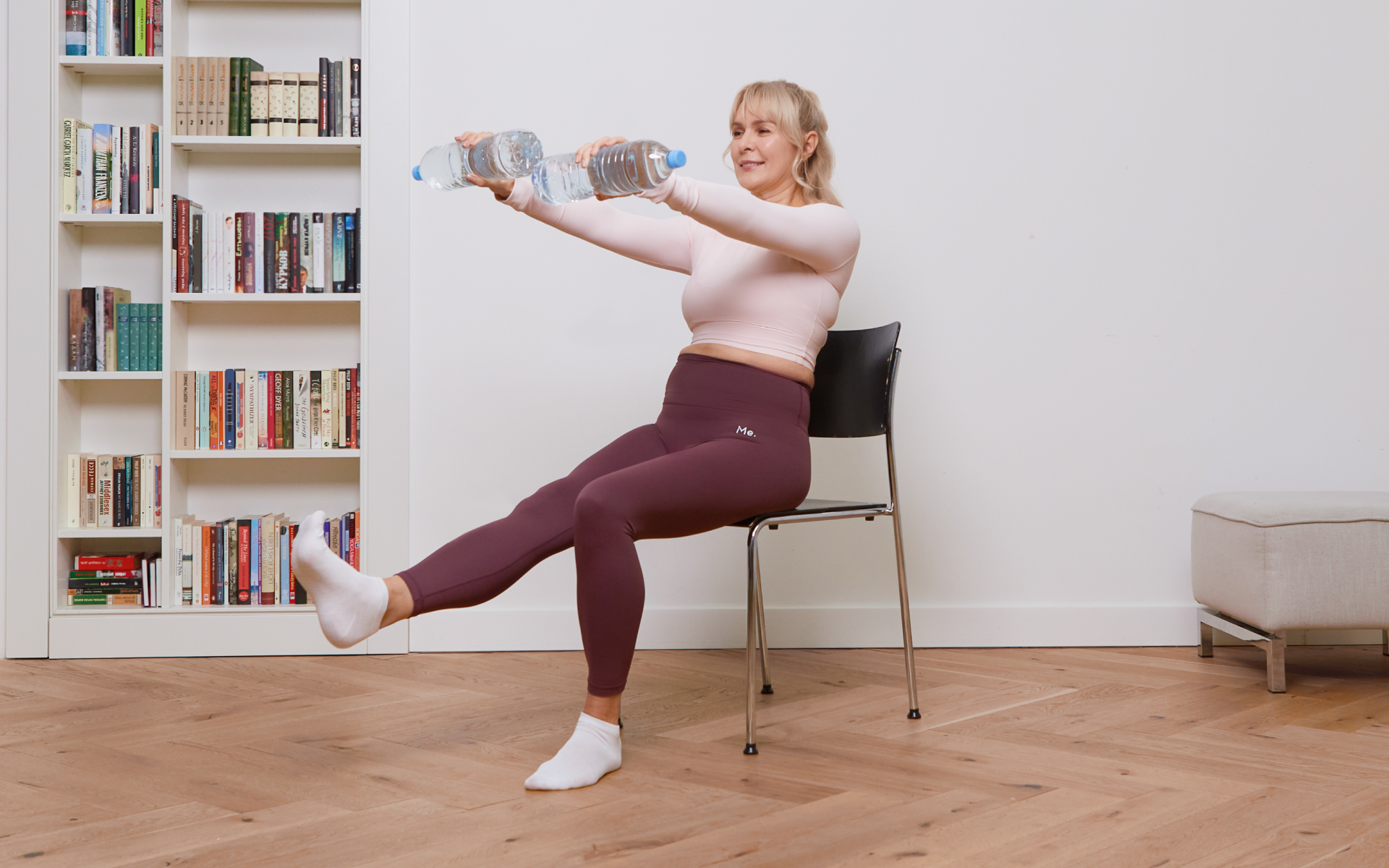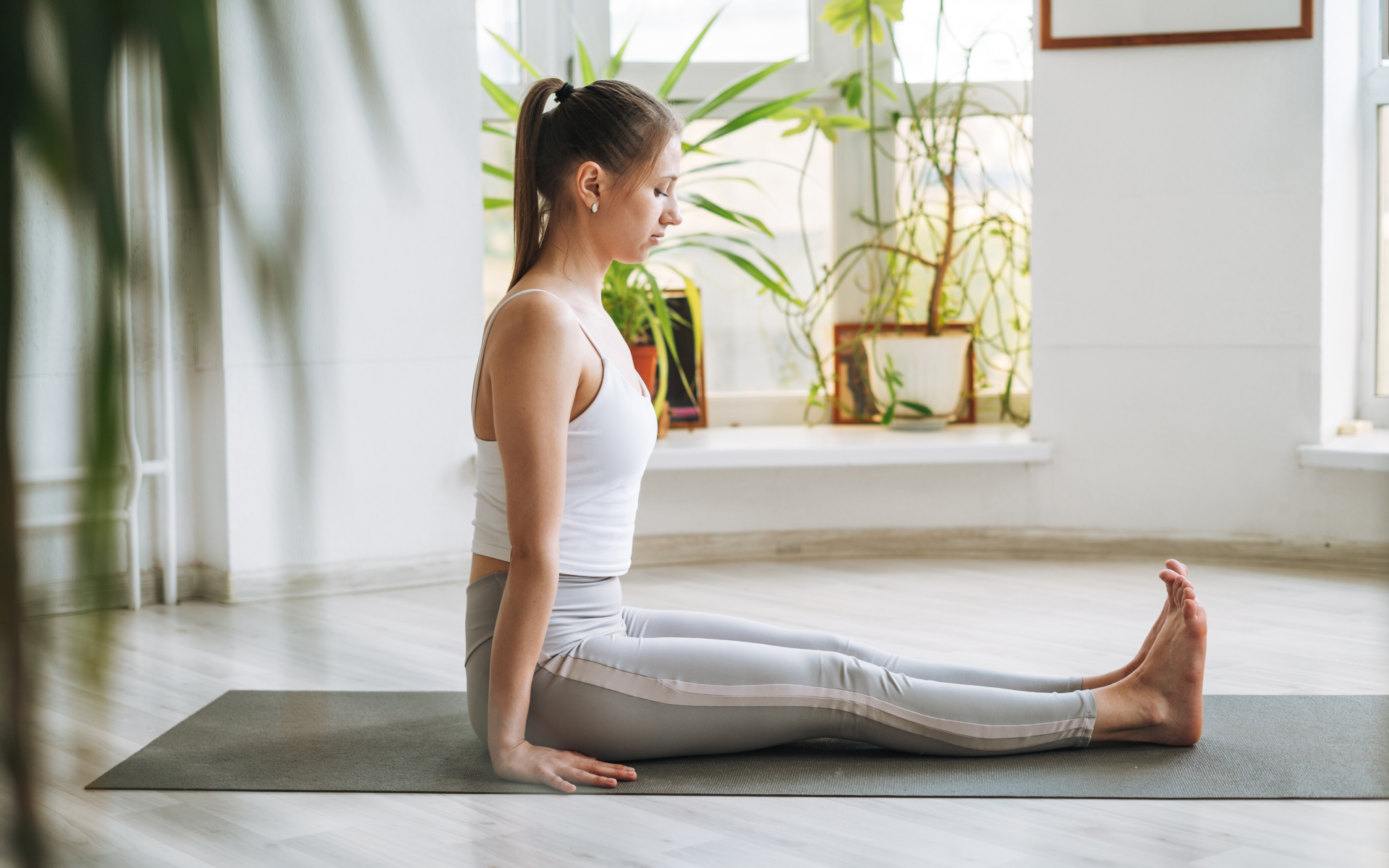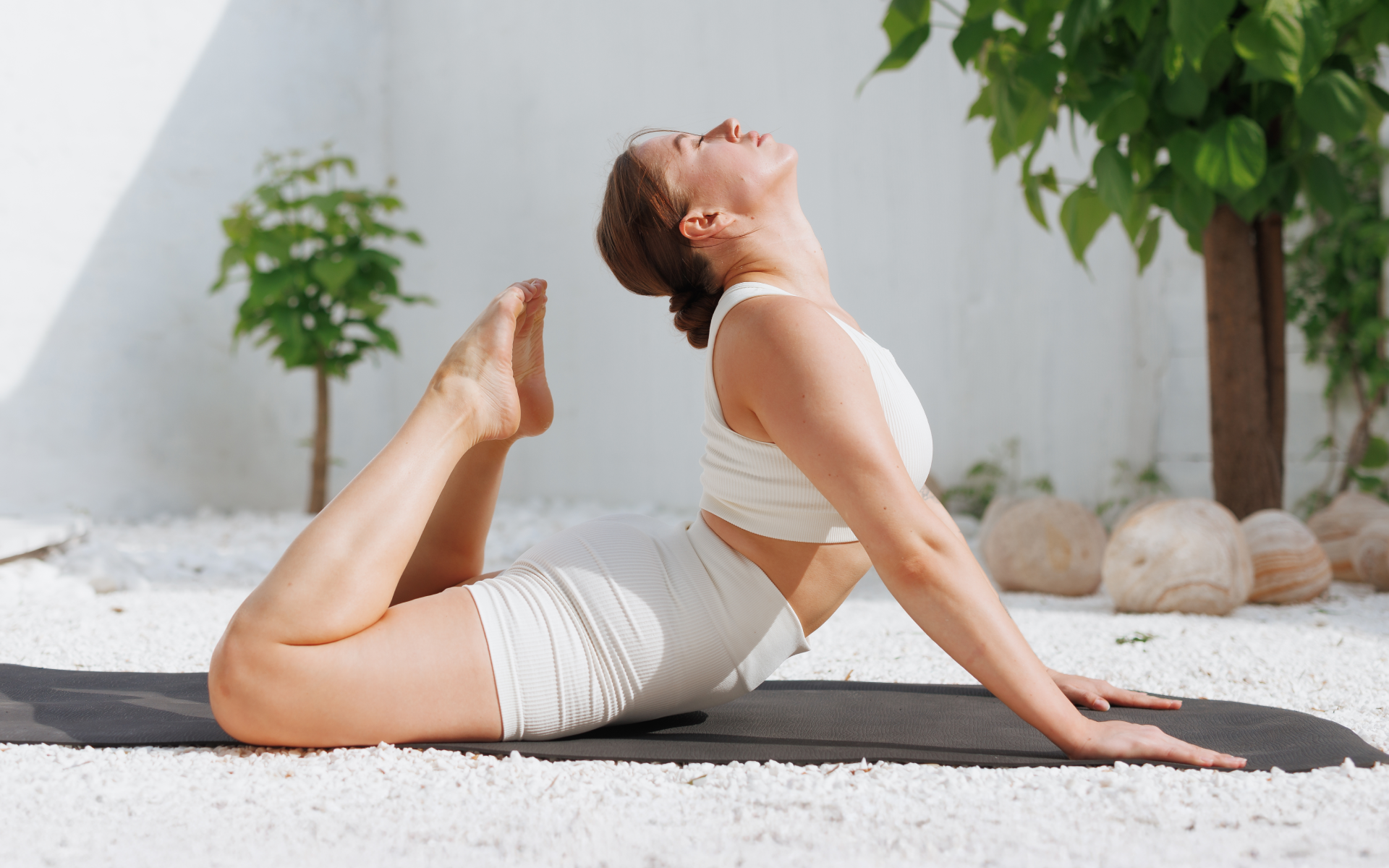Not all movement needs to be intense or fast-paced to make an impact. Sometimes, slowing down is exactly what your mind and body need to reset and reconnect.
Yin yoga is a gentle, slow-paced form of yoga that involves holding stretches deeply for extended periods of time (1). While it’s not always categorized as a somatic exercise, it shares many of the same principles, particularly in its emphasis on internal awareness of bodily sensations during movement.
When it’s practiced with this inward focus, yin yoga can serve as a somatic practice. However, when it’s approached solely to achieve physical goals such as flexibility or joint health, it falls outside the definition of somatic movement (2).
This article will break down what yin yoga is, how it relates to somatic practices, its key benefits, and what you need to know before getting started.
Is Yin Yoga Somatic Exercise?
Yin yoga is a slow, intentional style of yoga that involves holding poses for extended periods to target the fascia, joints, and deep connective tissues (1). The idea is that by sinking into each pose for several minutes, you can start to uncover patterns of tension or discomfort deep within the body that might otherwise go unnoticed.
Unlike fast-paced “yang” styles such as vinyasa or power yoga, which often focus on fitness-based goals like strength and flexibility, yin yoga encourages you to slow down and pay attention to how your mind and body feel during each moment of stillness (1).
While yin yoga isn’t always classified as a somatic exercise, it shares many of the same principles when it’s practiced with an emphasis on internal awareness (2). In this way, yin yoga as a somatic practice is much more than simply stretching; it’s about reconnecting with your mind and body from the inside out to support overall well-being (3).
Why Is Yin Yoga So Powerful?
Yin yoga offers a unique approach to movement that can be particularly powerful for those with busy, fast-paced lifestyles. Instead of pushing your body harder, it invites you to slow down, be still, and turn your attention inward (1).
There’s often more power in slowing down than we realize, which is exactly what yin yoga helps you tap into. The following sections explain the philosophy behind yin yoga, the benefits it may offer, and how it compares to other popular yoga styles.
The Energy Philosophy Behind Yin Yoga
Yin yoga is rooted in ancient Chinese philosophy and Taoist principles, particularly the concept of Qi: a vital life force believed to flow through energy channels in the body (4).
This philosophy teaches that optimal well-being depends on balancing two opposing yet complementary forces: yin and yang (5). When these forces are in harmony, Qi is said to flow most freely, supporting overall health and well-being (4).
In this framework, yin and yang are typically described as follows (5):
- Yin: Passive, calm, still, and inward-focused
- Yang: Active, energetic, and outward-driven
With so many of us leading busy, fast-paced lives, it’s easy to get stuck in a constant yang state – always moving, pushing, and doing – which can throw off your energy balance. Yin yoga offers a powerful counterbalance, which helps you slow down, pause, and reconnect with yourself when the intensity of daily life becomes too much (1).
Reasons why BetterMe is a safe bet: a wide range of calorie-blasting workouts, finger-licking recipes, 24/7 support, challenges that’ll keep you on your best game, and that just scratches the surface! Start using our app and watch the magic happen.
Comparing Yin Yoga to Other Yoga Styles
Many modern yoga styles lean heavily toward yang energy, often focusing on flexibility, strength, and other measures of physical performance (6). They’re usually faster-paced and use yoga poses to achieve certain fitness goals.
In contrast, yin yoga is slower and more meditative and shares similarities with gentler mind-body styles such as hatha yoga (1). However, when comparing yin yoga with hatha yoga, yin poses use longer-held poses to reach deeper connective tissues, while hatha yoga focuses on deep breathing through mindful, flowing movement (7). Our previous post goes into great detail about yin yoga vs hatha.
All yoga styles have their place, and some people find that combining yin and yang styles offers the most benefit. The key is to find a routine that supports your body’s changing needs and energy levels as they shift from day to day.
Benefits of Yin Yoga
Yin yoga offers a range of potential benefits, but it’s important to remember that the effects can vary widely from person to person. While some may notice positive results right away, others may take longer to feel relief.
That being said, here are the most common benefits of engaging in yin yoga:
- Stress relief and relaxation (8)
- Enhanced mindfulness (8)
- Reduced anxiety response to stressful events (8, 9)
- Improved flexibility, balance, and joint mobility (10, 11)
While yin yoga can support well-being, it should never replace medical or mental health care. If you’re dealing with any existing health concerns, always consult your primary care provider before you jump into any new movement routine.
For those who are looking for more emotional support, therapeutic yin yoga can be helpful, but it’s best done with the guidance of a qualified mental health professional to ensure your safety, comfort, and the best possible outcome (12).
Does Yin Yoga Release Emotions?
Yin yoga works by gently unblocking stagnant energy and restoring balance within the body (1, 13). Holding yin yoga poses for long periods can sometimes bring long-held emotions to the surface, reflecting the deep mind-body connection at play (22).
This is partly why yin yoga for trauma is gaining more recognition, as it helps calm an overactivated nervous system (14). However, it’s essential to approach this kind of emotional work carefully, ideally under the guidance of a yoga practitioner who is trained in trauma-informed practices.
Read more: At-Home Somatic Therapy: Exercises To Regulate Your Emotions
How to Practice Yin Yoga
Starting your own yin yoga practice may feel a little intimidating at first, but it’s actually quite accessible. You don’t need any previous experience, flexibility, or a certain fitness level to get started, which makes it ideal for beginners, older adults, or anyone who is looking for a gentle, restorative form of movement.
While everyone’s routine will look a little different, having a simple framework to guide you can make the process easier and more enjoyable. Here are some steps to consider as you start your yin yoga practice:
1. Set up your space
Creating a quiet, calming space in which you can relax without interruptions is the first step toward a successful yin yoga practice. A distraction-free environment can help you stay present and fully experience the stillness yin yoga encourages (15).
Here are some ways to make your space as calming and rewarding as possible:
- Choose a quiet room, a peaceful corner, or an outdoor spot where you feel comfortable and won’t be interrupted.
- Use a yoga mat and soft props such as pillows, folded blankets, or a yoga block to support your body during longer holds.
- Silence your phone, let others know you need uninterrupted time, and remove anything else that may be distracting.
- Consider dimming the lights or using candles to create a soothing atmosphere.
2. Choose the right sequence
Next, it’s important to choose a yoga sequence that fits your needs and lifestyle, which can vary widely from person to person. One way to start is habit stacking, or attaching a short yoga session to an existing habit, to make it a regular part of your routine (16).
For example, if you already have a steady morning routine, incorporating a morning yin yoga sequence can be a helpful way to remain consistent in the beginning without feeling as if you’re starting from scratch.
Starting small can also help you avoid feeling overwhelmed, which makes it easier to stay consistent over time (16). Start with short sessions to ease into the practice, and then gradually build your way up to longer sequences as you grow more comfortable.
Apps like BetterMe can be a great resource for discovering new sequences and varying your routine as your yin yoga practice evolves.
3. Ease into each pose slowly
Yin yoga is all about holding long, still poses – usually between 3 and 5 minutes, and sometimes up to 20 minutes or even a 1-hour yin yoga sequence. These long holds help release tension in the body, but can feel unfamiliar for those who are used to more active movement.
Try these tips to ease into each yin yoga pose safely and comfortably:
- Use props (e.g., folded blanket, yoga block) to support your body, allowing you to fully relax and be present in the moment.
- Move into each pose very slowly, adjusting until you find gentle resistance (not pain, strain, or discomfort).
- Never force yourself deeper into a stretch; instead, let gravity do the work and guide you through each pose.
4. Practice mindful stillness
One of the most restorative aspects of yin yoga is its emphasis on mindfulness, which involves tuning in to subtle sensations, thoughts, or emotions in the current moment without judgment or trying to change anything (17).
Staying present during stillness is key to getting the most out of your practice, but it can take some time to get used to. Here are some tips to help you remain mindful:
- Approach each session as a new chance to slow down and listen to your body.
- In each pose, gently notice areas of tension, tightness, or discomfort without judgment or trying to change them.
- Observe any thoughts or emotions that come up with curiosity, allowing them to pass naturally.
- Keep your breath steady, using it to stay anchored in the present moment (18).
5. End with a gentle restorative pose
After your final pose, always give yourself time to rest in a gentle restorative position such as Savasana (or corpse pose) (19). This gives your body time to absorb the benefits of the session and reflect on any feelings that potentially came up.
Think of this final rest as a reset – a chance to fully unwind, reconnect with yourself, and transition back into your day with a calmer, more grounded mindset.
Read more: Does Somatic Yoga Really Work? Here’s What You Need to Know
What to Expect from a Somatic Yin Yoga Practice
If you’re new to somatic yin yoga, you may be surprised by just how deep this gentle practice can go. While the poses themselves are more passive and calming, the effects often reach well beyond your muscles. The sections below break down some common questions that may arise as you explore yin yoga.
Can Yin Yoga Change Your Body?
Yes, yin yoga can change your body, just not in the way high-intensity workouts do. By holding poses for longer periods, yin yoga targets deeper connective tissues, reaching areas that are often neglected or overlooked in faster-paced styles (1).
For noticeable results, incorporating a full-body yin yoga sequence can be particularly effective. However, the most important aspect is consistency, so it’s best to start small and gradually work your way up to longer sessions.
BetterMe: Health Coaching app helps you achieve your body goals with ease and efficiency by helping to choose proper meal plans and effective workouts. Start using our app and you will see good results in a short time.
Why Am I So Tired After Yin Yoga?
Feeling drained after yin yoga is quite common and is usually nothing to worry about.
This type of practice activates the parasympathetic nervous system (your body’s “rest and digest” mode), helping the body shift out of a high-alert state (20). As you release stored tension, you may also notice emotional shifts lingering beneath the surface.
This can result in a deep, calming fatigue that often feels more emotional than physical (21). It’s often a sign that your body is decompressing, so give yourself permission to rest and fully relax afterward.
That being said, yin yoga should never cause pain or excessive discomfort. If you experience negative physical symptoms, consult your healthcare provider to ensure the practice is suitable for your health needs and goals.
What Happens if You Do Yin Yoga Every Day?
A daily yin yoga practice can be useful, particularly if you tailor it to how you’re feeling each day. That being said, longer or intense sessions every day may be too much for some people, particularly those who are dealing with any kind of emotional or physical sensitivity.
If you’re interested in a daily practice, consider alternating full sequences with shorter sessions to create variety in your routine. And as always, listen to your body, rest when needed, and avoid pushing past your body’s limits.
When Should You Not Practice Yin Yoga?
Yin yoga is generally safe for most people, but there are times when it may be best to pause or modify your session.
If you’re managing an acute injury, inflammation, or certain joint issues, deep stretching could make your symptoms worse. In addition, it’s best to avoid yin yoga when you feel physically exhausted or emotionally overwhelmed, as the stillness may intensify any unprocessed emotions.
If you’re in doubt, always consult your primary care provider to get more guidance and personalized advice that is tailored to your health needs and goals.
In traditional Chinese philosophy, “yin” emotions are typically associated with inward, passive, and calming states (23). Yin energy often relates to emotional experiences that encourage reflection and release, including a wide range of feelings such as sadness, grief, fear, and introspection. Yoga can help release emotions that are stored or “trapped” in the body, particularly slower and more therapeutic yoga styles (22). By holding poses for extended periods, yin yoga can allow emotional blockages to surface and gradually dissipate. However, this process varies widely and should be approached with professional care. Mild soreness or discomfort after yin yoga can occur, as the practice targets deep connective tissues within the body (1). Holding these long poses engages the muscles differently from other yoga styles, which may cause temporary stiffness or aching. However, any pain that is sharp, intense, or persists long after the practice should be evaluated by a healthcare professional. Yin yoga focuses on long holds and mind-body awareness, and not so much cardio or building muscle (1). While it can be a great addition to your workout routine, it’s not meant to replace more vigorous exercise if you’re aiming for certain fitness goals.Frequently Asked Questions
What emotions are yin?
Does yoga release trapped emotions?
Why does my body hurt after yin yoga?
Can you get fit from yin yoga?
The Bottom Line
Yin yoga offers a unique and powerful way to slow down and find balance in the fast pace of daily life. Whether you’re just getting started or looking to deepen your practice, staying open and mindful of how your body and mind feel will help you get the most out of every session.
If you’re looking for extra support, check out the BetterMe app, which is full of helpful tips, tutorials, and even guided sessions to keep you motivated and on track.
DISCLAIMER:
This article is intended for general informational purposes only and does not serve to address individual circumstances. It is not a substitute for professional advice or help and should not be relied on for making any kind of decision-making. Any action taken as a direct or indirect result of the information in this article is entirely at your own risk and is your sole responsibility.
BetterMe, its content staff, and its medical advisors accept no responsibility for inaccuracies, errors, misstatements, inconsistencies, or omissions and specifically disclaim any liability, loss or risk, personal, professional or otherwise, which may be incurred as a consequence, directly or indirectly, of the use and/or application of any content.
You should always seek the advice of your physician or other qualified health provider with any questions you may have regarding a medical condition or your specific situation. Never disregard professional medical advice or delay seeking it because of BetterMe content. If you suspect or think you may have a medical emergency, call your doctor.
SOURCES:
- A Journey Into Yin Yoga (2019, books.google.com)
- Letting Go with Bodily Awareness and Somatic Movement (2024, liebertpub.com)
- Exploring the therapeutic effects of yoga and its ability to increase quality of life (2011, nih.gov)
- The yin, yang, and anatomy of Traditional Chinese Medicine in The Anatomical Record (2023, anatomypubs.onlinelibrary.wiley.com)
- Applying a Yin–Yang Perspective to the Theory of Paradox: A Review of Chinese Management (2021, nih.gov)
- The Yoga Boom in Western Society: Practitioners’ Spiritual vs. Physical Intentions and Their Impact on Psychological Wellbeing (2015, researchgate.net)
- Hatha Yoga: Benefits and Principles for a More Meaningful Practice (2010, journals.lww.com)
- Impact of a Yin Yoga and meditation intervention on pharmacy faculty and student well-being (2021, sciencedirect.com)
- The effect of yin yoga intervention on state and trait anxiety during the COVID-19 pandemic (2024, nih.gov)
- The effects of a yoga intervention on balance and flexibility in female college students during COVID-19: A randomized controlled trial (2023, nih.gov)
- Impact of 10-weeks of yoga practice on flexibility and balance of college athletes (2016, nih.gov)
- Medical Yoga Therapy (2017, nih.gov)
- Effects of yoga practice on acumeridian energies: Variance reduction implies benefits for regulation (2013, nih.gov)
- The experience of yoga for persons with complex interpersonal trauma: A phenomenological approach (2022, sciencedirect.com)
- The impact of yoga on occupational stress and wellbeing: exploring practitioners’ experiences (2024, nih.gov)
- Making health habitual: the psychology of ‘habit-formation’ and general practice (2012, nih.gov)
- Mindfulness and Behavior Change (2020, nih.gov)
- Yogic Breathing and Mindfulness as Stress Coping Mediate Positive Health Outcomes of Yoga (2019, link.springer.com)
- Shavasana—Relaxation technique to combat stress (2007, sciencedirect.com)
- Anatomy, Autonomic Nervous System (2023, nih.gov)
- Feeling Tired After Yoga? Here Are 6 Reasons Why (and Tips) (2021, thesatoriconcept.com)
- Benefits and Limitations of Yin Yoga for Trauma (n.d., breathingdeeply.com)
- Understanding Yin and Yang Energy In Emotions: It Can Help You Create True Emotional Well-Being (2025, phyto5.us)
